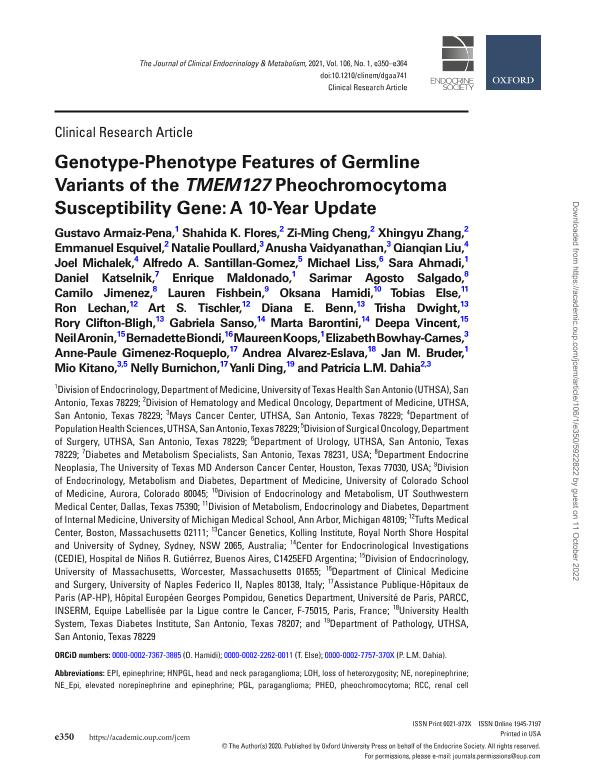Artículo
Genotype-phenotype features of germline variants of the TMEM127 pheochromocytoma susceptibility gene: A 10-year update
Armaiz Pena, Gustavo; Flores, Shahida K.; Cheng, Zi Ming; Zhang, Xhingyu; Esquivel, Emmanuel; Poullard, Natalie; Vaidyanathan, Anusha; Liu, Qianqian; Michalek, Joel; Santillan Gomez, Alfredo A.; Liss, Michael; Ahmadi, Sara; Katselnik, Daniel; Maldonado, Enrique; Salgado, Sarimar Agosto; Jimenez, Camilo; Fishbein, Lauren; Hamidi, Oksana; Else, Tobias; Lechan, Ron; Tischler, Art S.; Benn, Diana E.; Dwight, Trisha; Clifton Bligh, Rory; Sanso, Elsa Gabriela ; Barontini, Marta Beatriz
; Barontini, Marta Beatriz ; Vincent, Deepa; Aronin, Neil; Biondi, Bernadette; Koops, Maureen; Bowhay Carnes, Elizabeth; Gimenez Roqueplo, Anne Paule; Alvarez Eslava, Andrea; Bruder, Jan M.; Kitano, Mio; Burnichon, Nelly; Ding, Yanli; Dahia, Patricia L. M.
; Vincent, Deepa; Aronin, Neil; Biondi, Bernadette; Koops, Maureen; Bowhay Carnes, Elizabeth; Gimenez Roqueplo, Anne Paule; Alvarez Eslava, Andrea; Bruder, Jan M.; Kitano, Mio; Burnichon, Nelly; Ding, Yanli; Dahia, Patricia L. M.
 ; Barontini, Marta Beatriz
; Barontini, Marta Beatriz ; Vincent, Deepa; Aronin, Neil; Biondi, Bernadette; Koops, Maureen; Bowhay Carnes, Elizabeth; Gimenez Roqueplo, Anne Paule; Alvarez Eslava, Andrea; Bruder, Jan M.; Kitano, Mio; Burnichon, Nelly; Ding, Yanli; Dahia, Patricia L. M.
; Vincent, Deepa; Aronin, Neil; Biondi, Bernadette; Koops, Maureen; Bowhay Carnes, Elizabeth; Gimenez Roqueplo, Anne Paule; Alvarez Eslava, Andrea; Bruder, Jan M.; Kitano, Mio; Burnichon, Nelly; Ding, Yanli; Dahia, Patricia L. M.
Fecha de publicación:
01/2021
Editorial:
Endocrine Society
Revista:
Journal of Clinical Endocrinology and Metabolism
ISSN:
0021-972X
e-ISSN:
1945-7197
Idioma:
Inglés
Tipo de recurso:
Artículo publicado
Clasificación temática:
Resumen
Purpose: This work aimed to evaluate genotype-phenotype associations in individuals carrying germline variants of transmembrane protein 127 gene (TMEM127), a poorly known gene that confers susceptibility to pheochromocytoma (PHEO) and paraganglioma (PGL). Design: Data were collected from a registry of probands with TMEM127 variants, published reports, and public databases. Main Outcome Analysis: Clinical, genetic, and functional associations were determined. Results: The cohort comprised 110 index patients (111 variants) with a mean age of 45 years (range, 21-84 years). Females were predominant (76 vs 34, P <. 001). Most patients had PHEO (n = 94; 85.5%), although PGL (n = 10; 9%) and renal cell carcinoma (RCC, n = 6; 5.4%) were also detected, either alone or in combination with PHEO. One-third of the cases had multiple tumors, and known family history was reported in 15.4%. Metastatic PHEO/PGL was rare (2.8%). Epinephrine alone, or combined with norepinephrine, accounted for 82% of the catecholamine profiles of PHEO/PGLs. Most variants (n = 63) occurred only once and 13 were recurrent (2-12 times). Although nontruncating variants were less frequent than truncating changes overall, they were predominant in non-PHEO clinical presentations (36% PHEO-only vs 69% other, P <. 001) and clustered disproportionately within transmembrane regions (P <. 01), underscoring the relevance of these domains for TMEM127 function. Integration of clinical and previous experimental data supported classification of variants into 4 groups based on mutation type, localization, and predicted disruption. Conclusions: Patients with TMEM127 variants often resemble sporadic nonmetastatic PHEOs. PGL and RCC may also co-occur, although their causal link requires further evaluation. We propose a new classification to predict variant pathogenicity and assist with carrier surveillance.
Archivos asociados
Licencia
Identificadores
Colecciones
Articulos(CEDIE)
Articulos de CENTRO DE INVESTIGACIONES ENDOCRINOLOGICAS "DR. CESAR BERGADA"
Articulos de CENTRO DE INVESTIGACIONES ENDOCRINOLOGICAS "DR. CESAR BERGADA"
Citación
Armaiz Pena, Gustavo; Flores, Shahida K.; Cheng, Zi Ming; Zhang, Xhingyu; Esquivel, Emmanuel; et al.; Genotype-phenotype features of germline variants of the TMEM127 pheochromocytoma susceptibility gene: A 10-year update; Endocrine Society; Journal of Clinical Endocrinology and Metabolism; 106; 1; 1-2021; 350-364
Compartir
Altmétricas



